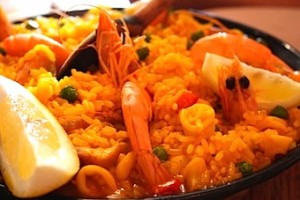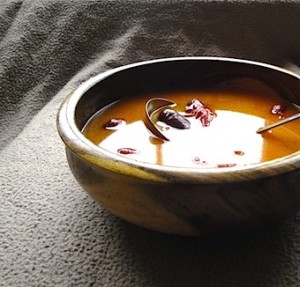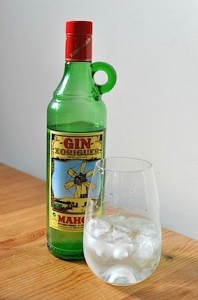
The wide number of varieties of Menorca food and drink are a complex blend of the influences left by the many invaders and occupiers over thousands of years, from the Romans and Arabs to the French and British.  This, coupled with the fact that the island – declared a UNESCO Biosphere Reserve in 1993 – has some of the best agricultural produce of the Baleraric Islands, means that its gastronomy is rich, varied and unique.
This, coupled with the fact that the island – declared a UNESCO Biosphere Reserve in 1993 – has some of the best agricultural produce of the Baleraric Islands, means that its gastronomy is rich, varied and unique.
Seafood has always been of utmost importance here and the island also has a long history of cattle farming, both for meat and dairy production. With such an excellent range of staple products, Menorca food and drink can be said to combine the best of both land and sea.
Perhaps the best-known seafood dish is the ‘caldereta de llagosta’, a delicious and succulent lobster stew served on fine slices of toast. Made from the spiny blue lobster caught in the waters close to the coast, the dish is a favourite with visitor and resident alike and is a popular item for the traditional family Sunday lunches served in restaurants along the coast.
Other well-known and popular seafood dishes are ‘escopinyes’, clams eaten raw with lemon or baked with a mixture of breadcrumbs, parsley and garlic. Baked sea bream, squid and octopus or grilled red mullet served with the delicious small potatoes of the island are always a popular meal on local menus.
Mayonnaise: Menorca lays claim to the discovery of mayonnaise, first produced in Mao (Mahon) in the mid-18th century by a French chef. This rich sauce took Europe by storm at the time and, although some French chefs still insist mayonnaise is an exclusively French invention, in Menorca people have no doubt that the sauce was first made in Mao, hence the name mayonnaise, and is best, they say, on the island, made with good local eggs and olive oil.
Meat: The island’s meat products are also well known for their quality and flavour, with the typical sobrasade (a pork sausage-meat made with red peppers) and the traditional carn i xua (sausage made of lean meat, bacon cubes and seasoning) forming a vital part of many Menorcan rich winter dishes.
Cheese: The cheese is special in Menorca because of the weather, the type of cows and what they eat – with the winds bringing sea water salt to the fields.
Wine: Wine production two centuries ago was a vital part of the island’s economy, especially with so many troops billeted on the island during the French and British occupations. The calcium-rich soil of the island plus the hot long days of summer sun and the relatively cool nights are perfect for bringing good flavour in the grapes. One Menorcan wine, the Vinifadet Chardonnay, was selected for the wine list of El Bulli in Cataluna, the world’s best restaurant of 2008.
Gin: The presence of so many British sailors in Menorcan ports during the 18th century also had another lasting influence. Gin was a favourite tiple of the Navy at the time and within a few months of British occupation stills had been set up and a distinctive local gin was being produced. Today the aromatic gin of Mao is well known and is still produced from a secret recipe flavoured with local juniper berries in the traditional way using copper stills.
Sweet Dishes: The Menorcan sweet dishes are justifably well-known throughout Spain, with delicious small cakes made with almonds or toasted nougat and the very popular and traditional ensaimadas, a delicious circular soft pastry cake covered in icing sugar that melts in the mouth.
Traditional Cuisine: In the 20th century, the traditional cuisine of the island was in danger of disappearing, as busy modern families found there was little time for the elaborate and lengthy preparation of food as carried out in the past by the grandmothers and womenfolk of the large extended families. But today, some chefs on the island believe that the old recipes and ways of cooking represent a vital part of Menorcan culture and should be preserved. As a result there is a thriving movement to ensure that traditional dishes are returning to the menus of many restaurants, so preserving and combining the best of old and new.

Menorca’s Dish of Excellence – Lobster Stew Recipe
Ingredients for 4 people:
- 1.6kg of live lobster (preferably one piece)
- 16 slices of traditional white unsalted bread (not French-style baguette)
- 1 large onion
- 1 large ripe tomato
- 2 cloves of garlic
- 1 sprig of fresh parsley
- 4 cups of broth (the liquid from boiling the lobster)
- 1 cup of tomato puree
- 2 tablespoons of brandy
- 2 cups of olive oil
- Salt and pepper
Preparation:
Tie the lobster and boil in 5 cups (1/4-litre) water. Cook for 15 minutes. Remove from heat and let cool.
Use hands to divide so that each serving has a piece of tail, body and claws.
Peel the onion, tomatoes and garlic. Clean the parsley and chop finely.
Heat oil in a solid clay pot, brown the onion on low heat stirring continuously, when soft add the tomatoes and garlic. Gently fry until caramelised. Add parsley and lobster pieces, salt and pepper and boil for 20 minutes on medium heat. Add tomato puree and brandy and cook for 5 more minutes before serving.
Serve with slices of bread, which are used for dipping into the stew and fishing out corresponding portions of lobster!





